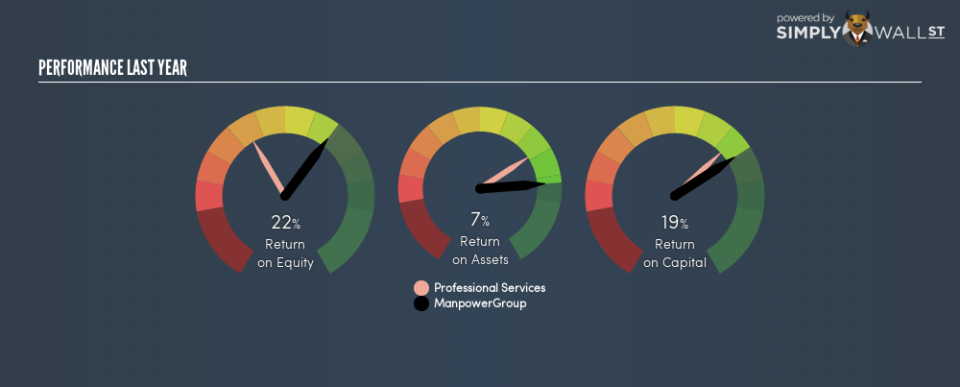Are ManpowerGroup Inc.’s (NYSE:MAN) High Returns Really That Great?

Today we are going to look at ManpowerGroup Inc. (NYSE:MAN) to see whether it might be an attractive investment prospect. In particular, we’ll consider its Return On Capital Employed (ROCE), as that can give us insight into how profitably the company is able to employ capital in its business.
Firstly, we’ll go over how we calculate ROCE. Next, we’ll compare it to others in its industry. Then we’ll determine how its current liabilities are affecting its ROCE.
Understanding Return On Capital Employed (ROCE)
ROCE measures the ‘return’ (pre-tax profit) a company generates from capital employed in its business. Generally speaking a higher ROCE is better. In brief, it is a useful tool, but it is not without drawbacks. Renowned investment researcher Michael Mauboussin has suggested that a high ROCE can indicate that ‘one dollar invested in the company generates value of more than one dollar’.
So, How Do We Calculate ROCE?
The formula for calculating the return on capital employed is:
Return on Capital Employed = Earnings Before Interest and Tax (EBIT) ÷ (Total Assets – Current Liabilities)
Or for ManpowerGroup:
0.19 = US$822m ÷ (US$8.7b – US$4.2b) (Based on the trailing twelve months to September 2018.)
Therefore, ManpowerGroup has an ROCE of 19%.
Check out our latest analysis for ManpowerGroup
Want to help shape the future of investing tools and platforms? Take the survey and be part of one of the most advanced studies of stock market investors to date.
Is ManpowerGroup’s ROCE Good?
When making comparisons between similar businesses, investors may find ROCE useful. In our analysis, ManpowerGroup’s ROCE is meaningfully higher than the 12% average in the Professional Services industry. We consider this a positive sign, because it suggests it uses capital more efficiently than similar companies. Regardless of where ManpowerGroup sits next to its industry, its ROCE in absolute terms appears satisfactory, and this company could be worth a closer look.
It is important to remember that ROCE shows past performance, and is not necessarily predictive. Companies in cyclical industries can be difficult to understand using ROCE, as returns typically look high during boom times, and low during busts. This is because ROCE only looks at one year, instead of considering returns across a whole cycle. Since the future is so important for investors, you should check out our free report on analyst forecasts for ManpowerGroup.
What Are Current Liabilities, And How Do They Affect ManpowerGroup’s ROCE?
Current liabilities include invoices, such as supplier payments, short-term debt, or a tax bill, that need to be paid within 12 months. Due to the way the ROCE equation works, having large bills due in the near term can make it look as though a company has less capital employed, and thus a higher ROCE than usual. To check the impact of this, we calculate if a company has high current liabilities relative to its total assets.
ManpowerGroup has total liabilities of US$4.2b and total assets of US$8.7b. Therefore its current liabilities are equivalent to approximately 48% of its total assets. With this level of current liabilities, ManpowerGroup’s ROCE is boosted somewhat.
What We Can Learn From ManpowerGroup’s ROCE
While its ROCE looks good, it’s worth remembering that the current liabilities are making the business look better. Of course, you might find a fantastic investment by looking at a few good candidates. So take a peek at this free list of companies with modest (or no) debt, trading on a P/E below 20.
I will like ManpowerGroup better if I see some big insider buys. While we wait, check out this free list of growing companies with considerable, recent, insider buying.
To help readers see past the short term volatility of the financial market, we aim to bring you a long-term focused research analysis purely driven by fundamental data. Note that our analysis does not factor in the latest price-sensitive company announcements.
The author is an independent contributor and at the time of publication had no position in the stocks mentioned. For errors that warrant correction please contact the editor at editorial-team@simplywallst.com.

